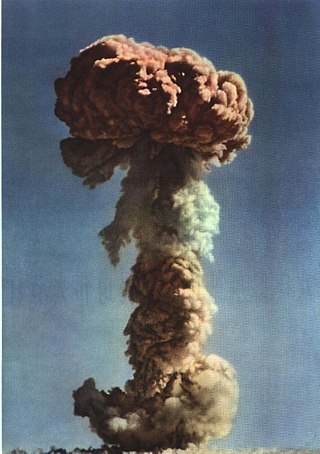Related Research Articles

"Fat Man" was the codename for the type of nuclear weapon the United States detonated over the Japanese city of Nagasaki on 9 August 1945. It was the second of the only two nuclear weapons ever used in warfare, the first being Little Boy, and its detonation marked the third nuclear explosion in history. The first one was built by scientists and engineers at Los Alamos Laboratory using plutonium manufactured at the Hanford Site and was dropped from the Boeing B-29 Superfortress Bockscar piloted by Major Charles Sweeney.
Smiling Buddha was the code name of India's first successful nuclear weapon test on 18 May 1974. The nuclear fission type bomb was detonated in the Pokhran Test Range of the Indian Army in Rajasthan. As per the United States military intelligence, the operation was named as Happy Krishna. The Indian Ministry of External Affairs (MEA) described the test as a peaceful nuclear explosion.

The Tsar Bomba, also known by the alphanumerical designation "AN602", was a thermonuclear aerial bomb, and the most powerful nuclear weapon ever created and tested. The Soviet physicist Andrei Sakharov oversaw the project at Arzamas-16, while the main work of design was by Sakharov, Viktor Adamsky, Yuri Babayev, Yuri Smirnov, and Yuri Trutnev. The project was ordered by Nikita Khrushchev in July 1961 as part of the Soviet resumption of nuclear testing after the Test Ban Moratorium, with the detonation timed to coincide with the 22nd Congress of the Communist Party of the Soviet Union.

Igor Vasilyevich Kurchatov, was a Soviet physicist who played a central role in organizing and directing the former Soviet program of nuclear weapons.

Operation Sandstone was a series of nuclear weapon tests in 1948. It was the third series of American tests, following Trinity in 1945 and Crossroads in 1946, and preceding Ranger. Like the Crossroads tests, the Sandstone tests were carried out at the Pacific Proving Grounds, although at Enewetak Atoll rather than Bikini Atoll. They differed from Crossroads in that they were conducted by the Atomic Energy Commission, with the armed forces having only a supporting role. The purpose of the Sandstone tests was also different: they were primarily tests of new bomb designs rather than of the effects of nuclear weapons. Three tests were carried out in April and May 1948 by Joint Task Force 7, with a work force of 10,366 personnel, of whom 9,890 were military.

The RDS-1, also known as Izdeliye 501 and First Lightning, was the nuclear bomb used in the Soviet Union's first nuclear weapon test. The United States assigned it the code-name Joe-1, in reference to Joseph Stalin. It was detonated on 29 August 1949 at 7:00 a.m., at the Semipalatinsk Test Site, Kazakh SSR, after top-secret research and development as part of the Soviet atomic bomb project.

The Soviet atomic bomb project was the classified research and development program that was authorized by Joseph Stalin in the Soviet Union to develop nuclear weapons during and after World War II.
RDS-6s was the first Soviet attempted test of a thermonuclear weapon that occurred on August 12, 1953, that detonated with a force equivalent to 400 kilotons of TNT.
RDS-37 was the Soviet Union's first two-stage hydrogen bomb, first tested on 22 November 1955. The weapon had a nominal yield of approximately 3 megatons. It was scaled down to 1.6 megatons for the live test.

Project 596 was the first nuclear weapons test conducted by the People's Republic of China, detonated on 16 October 1964, at the Lop Nur test site. It was a uranium-235 implosion fission device made from weapons-grade uranium (U-235) enriched in a gaseous diffusion plant in Lanzhou.

The Totskoye nuclear exercise was a military exercise undertaken by the Soviet Army to explore defensive and offensive warfare during nuclear war. The exercise, under the code name "Snowball", involved an aerial detonation of a 40 kt RDS-4 nuclear bomb. The stated goal of the operation was military training for breaking through heavily fortified defensive lines of a military opponent using nuclear weapons. An army of 45,000 soldiers marched through the area around the hypocenter soon after the nuclear blast. The exercise was conducted on September 14, 1954, at 9.33 a.m., under the command of Marshal Georgy Zhukov to the north of Totskoye village in Orenburg Oblast, Russia, in the South Ural Military District. The epicenter of the detonation is marked with a memorial.

RDS-4 was a Soviet nuclear bomb that was first tested at Semipalatinsk Test Site, on August 23, 1953. The device weighed approximately 1,200 kilograms (2,646 lb). The device was approximately one-third the size of the RDS-3. The bomb was dropped from an IL-28 aircraft at an altitude of 11 kilometres (7 mi) and exploded at 600 metres (1,969 ft), with a yield of 28 kt.
A modulated neutron initiator is a neutron source capable of producing a burst of neutrons on activation. It is a crucial part of some nuclear weapons, as its role is to "kick-start" the chain reaction at the optimal moment when the configuration is prompt critical. It is also known as an internal neutron initiator. The initiator is typically placed in the center of the plutonium pit, and is activated by impact of the converging shock wave.
RDS-3 was the third atomic bomb developed by the Soviet Union in 1951, after the RDS-1 and RDS-2. It was called Marya in the military. The bomb had a composite design with a plutonium core inside a uranium shell, providing an explosive power of 41.2 kilotons. The RDS-3T was a modernized version and the first mass-produced nuclear weapon by the Soviet Union. It was assigned to Long Range Aviation in 1953.
A nuclear torpedo is a torpedo armed with a nuclear warhead. The idea behind the nuclear warheads in a torpedo was to create a much bigger explosive blast. Later analysis suggested that smaller, more accurate, and faster torpedoes were more efficient and effective.
The RDS-2 nuclear warhead was created and designed by the Soviet Union during the late 1940s and early 1950s. RDS-2 was first secretly tested on September 24, 1951, at a Soviet test site in Kazakhstan. RDS-2 was a plutonium only device with an estimated yield of 38 kt.
The RDS-5 was a plutonium based Soviet atomic bomb, probably using a hollow core. Two versions were made. The first version used 2 kg Pu-239 and was expected to yield 9.2 kilotons. The second version used only 0.8 kg Pu-239.
German Arsenyevich Goncharov was a Russian physicist whose career mostly spent in the former Soviet program of nuclear weapons. Since 1952 until 2004, Goncharov developed and tested Soviet thermonuclear weapons and led a theoretical department at the Soviet nuclear research facility at Arzamas-16 from 1967 to 2004.

The 36th Bomber Division or 36th Air Division of the People's Liberation Army Air Force (PLAAF) is an air formation of the People's Republic of China (PRC). The 36th Bomber Division is one of only three bomber divisions in the PLAAF and is presently assigned to the Central Theater Command Air Force.
References
Citations
Bibliography
- Bukharin, Oleg; Von Hippel, Frank (2001). Podvig, Pavel Leonardovich (ed.). Russian Strategic Nuclear Forces. Cambridge Massachusetts: The MIT Press. ISBN 9780262162029.
- Andryushin, I.A.; Chernyshev, A.K.; Udin, Yu.A. (2003). УКРОЩЕНИЕ ЯДРА [Nuclear taming](PDF) (in Russian). Sarov: Red October. Archived from the original (PDF) on December 31, 2018.
- "РДС-27" [RDS-27] (in Russian). 20 March 2013. Archived from the original on January 3, 2019.
- "РДС-2 (1946 г., проект)" [RDS-1 / product 501]. Military Russia (in Russian). Archived from the original on April 10, 2018.
- "РДС-1 / изделие 501" [RDS-2 (1946, project)]. Military Russia (in Russian). Archived from the original on April 24, 2018.